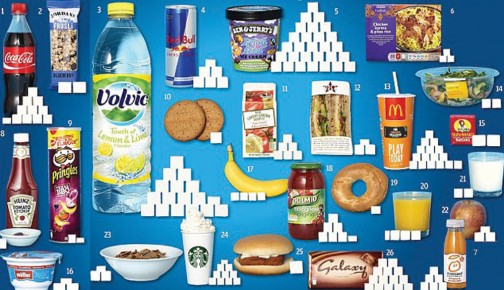17th April, 2012
 We all know the dangers of too much salt, fat and calories in our diet, but health professionals warn that not many of us consider our sugar intake.
We all know the dangers of too much salt, fat and calories in our diet, but health professionals warn that not many of us consider our sugar intake.
There are obvious sources of it — such as the Easter eggs consumed in large quantities at the weekend.
But the problem, experts say, is that our everyday diets are packed with ‘stealth’ sugar, sending our intake far above the recommended limits and placing us at risk of diseases, including diabetes and heart disease.
Sugar is also found in surprisingly large amounts in many savoury foods such as sauces and ready meals.
In fact, it’s highly likely to be a much bigger part of your diet than you realise, as investigation reveals. Ironically, ‘healthier’ reduced-fat foods can actually contain more sugar.
“Stripping out fat from processed foods makes them less appealing to our taste buds. The inevitable consequence is that manufacturers increase other ingredients, including sugar, to recreate taste and texture,” says Tam Fry of the National Obesity Forum.
Attempt to find out how much sugar is in our favourite foods and drinks — including those many consider healthy, gave a shocking revelation
UK guidelines recommend that ‘added’ sugars, those used to sweeten food, fizzy drinks, honeys, syrups and fruit juices, shouldn’t make up more than 10 per cent of the total energy we get from food.
This is around 50g of sugar a day, equivalent to 10 cubes of sugar for adults and older children, and nine for five to 10-year-olds.
But further findings reveal that just one 500ml bottle of Coke will send you over this limit. Other examples include a McDonald’s milkshake, which contains an incredible 16 cubes of sugar. Even a ‘healthy’ salad contains two cubes. Remember, we’re talking about sugar added as a sweetener.
The sugars in milk, vegetables and pieces of fruit (as opposed to fruit juice), including dried fruit, do not wreak as much havoc. On average, adults eat around 18 per cent more added sugars than is healthy
So if you’re getting most of your sugar from these sources, you can eat up to 18 cubes or 90g daily. For five to 10-year-olds, the figure is 17 cubes or 85g.
The two most common forms of unhealthy added sugars are table sugar (sucrose) and high-fructose corn syrup, a liquid sweetener made from maize. Both are added to countless foods, turning up in everything from fizzy drinks to chicken korma.
Sugars in fruit juices and honeys are also the unhealthy ‘added’ type.‘Added sugars are more likely to do harm as they aren’t safely bound in the structure of a food, as they are in fruit,’ says Sasha Watkins, a spokesperson for the British Dietetic Association.
‘It means they are available to the body in higher concentrations.’ But how can you spot a high sugar food? To interpret labels that list sugar (which is labelled as ‘total sugars’ and will include natural and added sugar), the NHS Choices website suggests that a food with less than 5g per 100g is classified as low.
More than 15g per 100g is high. Though we all need some sugar — it is the essential fuel that powers all cells in our body — excess levels have been linked with raised levels of the hormone insulin, which increases the risk of diabetes.
Furthermore, the body turns excess sugar into fat, which is stored around the major organs, placing us at risk of liver and heart disease. There are also fears that high sugar diets may promote some cancers. The theory is that glucose, one of the main ingredients in added sugar, creates repeated spikes of insulin.
For reasons that are not clear, many tumours seem to have insulin receptors, hence a rise in this hormone fuels their growth. It is the sheer quantity of sugar that we consume that creates the problem, says Roy Taylor, professor of medicine and metabolism at Newcastle University. “Sugar calories slip down so easily and lead to weight gain,” he said.
The sugar industry is quick to point to evidence that high sugar consumers are less likely to be overweight, which, paradoxically, can be true.They generally eat less fat, which has twice as many calories as sugar. But with sugary drinks, the link with obesity is far stronger. One study in 2007 found that youngsters consuming around 200 calories from sugary drinks (two glasses) increased their odds of being overweight by two-thirds.
—Henry Ojelu



